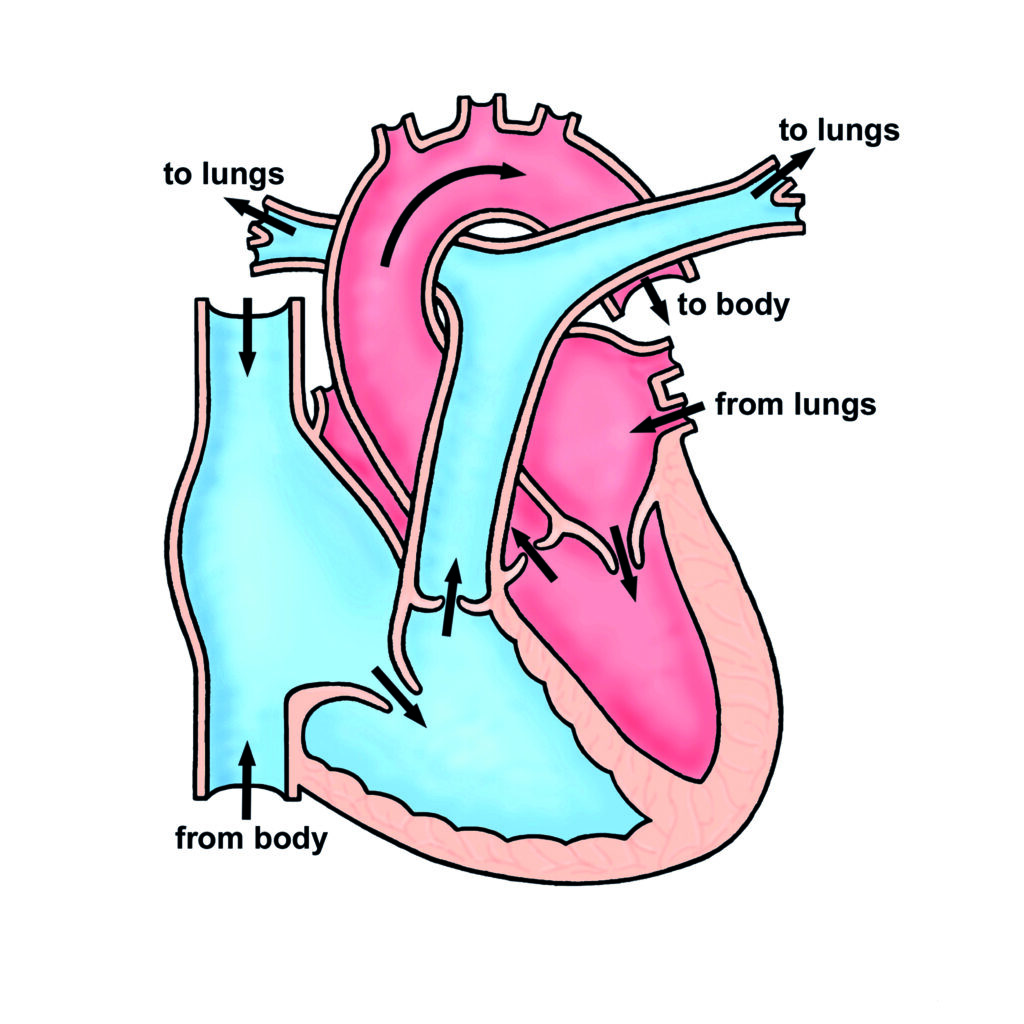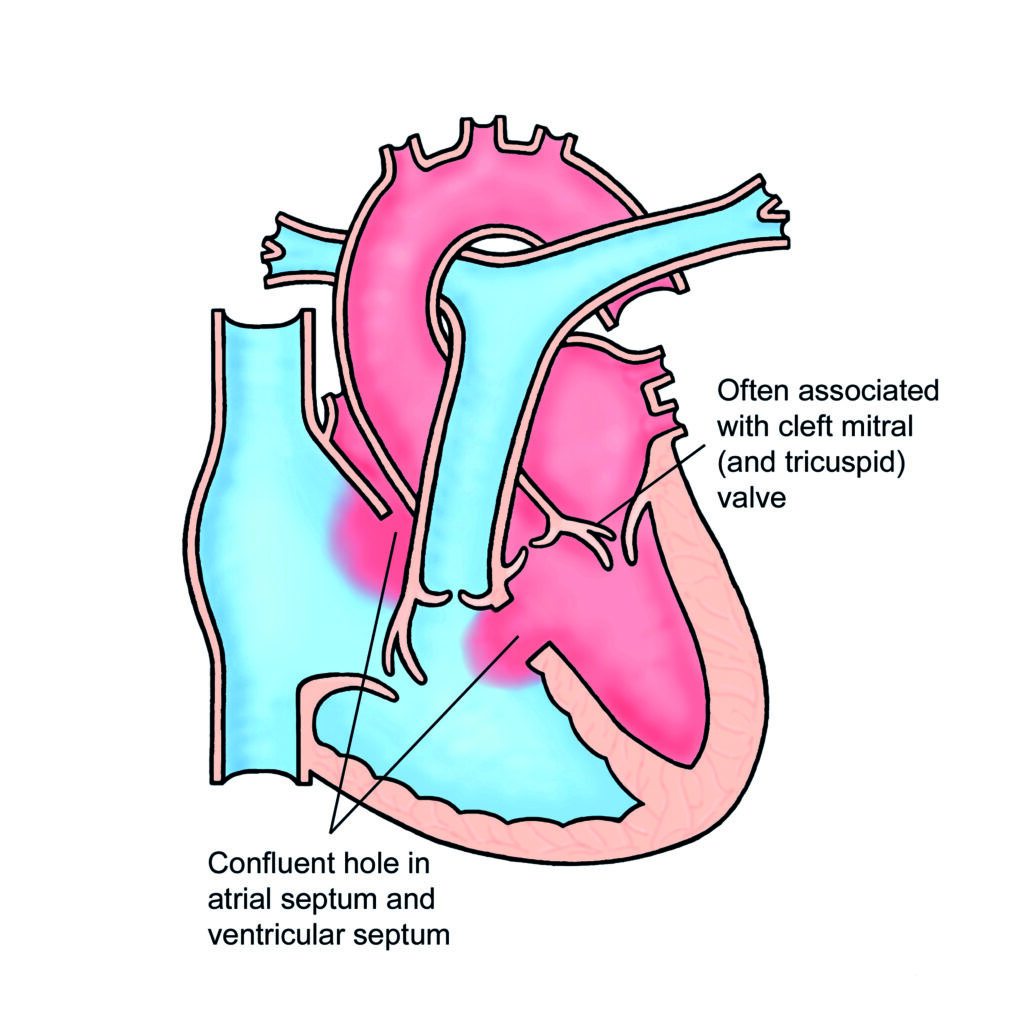This leaflet provides information for parents and carers about complete atrioventricular septal defect in children and the management and treatment of this condition.
Complete Atrioventricular Septal Defect
This is a serious heart abnormality which consists of a complicated hole between the right and left sides of the heart.
The hole occurs in the middle of the heart, causing a large hole between the two small pumping chambers (atria) and the between the two main pumping chambers (ventricles). The hole also affects the inlet valves of the heart.
Normally there is a separate inlet valve in the right side of the heart (the tricuspid valve) and a separate inlet valve in the left side (the mitral valve) but in an atrioventricular septal defect (AVSD) there is just one common valve.
This abnormality of the inlet valves in AVSD often stops the valves (particularly the mitral valve, on the left side of the heart) closing properly, so it is not watertight when it closes.


Tests
An ultrasound scan of the heart (an “echocardiogram”) is required to make the diagnosis, and to watch for any new problems developing as the child grows.
Treatment
Babies with AVSD usually look perfectly well when they are born, but they gradually become breathless over the first month or so after birth. When this happens medicines can help to some extent, but most babies require major heart surgery to try to repair the defect when they are about 3 months old. The surgery is very complicated because the surgeon has to try to close the 2 holes (using patches of material) at the same time as dividing the common inlet valve into two separate competent valves.
The main problem with surgery is that the left sided inlet valve always leaks to some extent after the holes are closed (this is called left AV valve regurgitation. If the left AV valve only leaks a little this may not matter and further treatment may never be necessary).
Here’s a video about Atrioventricular Septal Defect – AV Canal
Atrioventricular Septal Defect – AV Canal. YouTube
Atrioventricular Septal Defect – AV Canal
AV canal is a spectrum of relatively common congenital heart defects.
It accounts for about five percent of
all congenital heart disease and is most common in infants with Down Syndrome
This is the view from the left atrium.
An atrial septal defect, or ASD, is a completely open hole between the top chambers.
This is the view inside the heart from the apex of the right ventricle.
The mitral and tricuspid valves are combined into a single, common AV valve.
This is a ventricular septal defect commonly referred to as a VSD.
The lungs receive more blood flow than normal because of the ASD and VSD.
Oxygen-poor blue blood.
Oxygen-rich red blood.
Since more blood flow is pumped to the lungs, the heart has to work harder
to pump adequate blood to the body.
This leads to heart failure symptoms including fast breathing
and poor weight gain.
Once symptoms develop, surgery is typically necessary.
However if the left AV valve valve leaks badly it can be such a serious problem that the baby may die, or that further major surgery is needed to repair or replace the valve. Replacing the left AV valve (a metal valve is normally used) in small babies is a difficult procedure, carries a further risk to the baby‘s life and sometimes cannot be performed because the baby is too small. Anticoagulation therapy is necessary for life with a mechanical valve.
Further major surgery is always necessary after valve replacement in babies because they outgrow the valve. The risk of a baby dying at surgery to repair an AVSD will depend to some extent on how well the mitral valve works before the operation. 25% of children undergoing AVSD repair may require further surgery when they become adults.
Follow up
It is important for all children with a repaired AVSD to be seen in the cardiology outpatient department to make sure that mitral regurgitation does not become worse.
In addition, a small proportion of children can develop narrowing of the outflow of the left ventricle (subaortic stenosis) after repair of the AVSD. This may need surgical treatment.
General advice for the future
Children with repaired AVSD can live normal active lives, including all kinds of sport. Most have a normal exercise tolerance but if there is significant mitral regurgitation it is usual to be more breathless than normal on exercise.
All patients with a repaired AVSD will be at risk of infection in the heart (called
endocarditis). Such infections may be caused by infections of the teeth or gums. It is important to have good dental hygiene and to visit the dentist regularly. Ear or body piercing and tattooing are best avoided as they also carry a small risk of infection which may spread to the heart. For more information about endocarditis please see the link below: